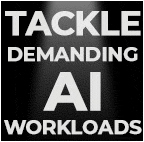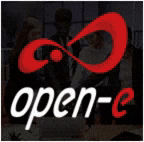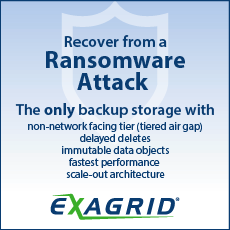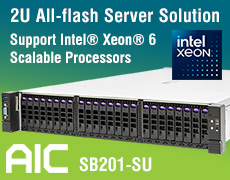Exclusive Interview With Jamie Lerner, CEO, Quantum
Acquisitions in analytics and AI/ML to come, and expanding into India and China
By Philippe Nicolas | October 26, 2021 at 2:02 pm Jamie Lerner, 51, is CEO, chairman and president of Quantum Corp. since 2018. Before that, he was COO of Pivot3 for almost 2 years, president of the cloud systems and solutions at Seagate, then Cisco for more than 4 years. He also led Cittio and worked for Xuma, Platinum Technologies and Andersen Consulting early in his career. On his free time, we can find him on the slopes snowboarding or on the water surfing.
Jamie Lerner, 51, is CEO, chairman and president of Quantum Corp. since 2018. Before that, he was COO of Pivot3 for almost 2 years, president of the cloud systems and solutions at Seagate, then Cisco for more than 4 years. He also led Cittio and worked for Xuma, Platinum Technologies and Andersen Consulting early in his career. On his free time, we can find him on the slopes snowboarding or on the water surfing.
Editor’s note: At a time, Quantum was among the top WW storage companies. In FY01, it records revenue of as much as $1.419 million, and having 3,400 employees. It was primary the result of its highly successful DLT, with big OEMs and also royalties on the tape media. The company then was desperately shrinking for a long time. Now sales for FY22 is estimated between $380 to $420 million, even if it’s an increase by 9% to 20% from FY21. Note a 22% Y/Y rebound in revenue also in 1FQ22, last published financial period. But net loss was recorded each quarter from 4FQ20 to 1FQ22. In conclusion, Quantum is far to be once more a $1 billion company.
StorageNewsletter: Quantum has been through many changes over the last decade. To what do you attribute the differences from 10 years ago to where the company stands today financially and strategically?
Lerner: In the past, Quantum was heavily focused on selling hardware and appliances, but in recent years the needs of our customers have led to a shift in strategy and focus to deliver comprehensive end-to-end data management solutions and services. We’ve moved beyond ‘just tape’ – although we are still a leader in that space and all that tape offers in terms of long-term, secure archiving – and now offer a wide range of solutions to capture, protect, store, manage, and enrich vast amounts of video and unstructured data. To support this, we’ve transitioned our business model from selling hardware and appliances only to selling software as subscription and as-a-service offerings. Financially, we are focused on long-term growth, and we believe our current offering, strategy and business model will drive that long-term, profitable growth.
Your market capitalization right now is less than your revenue, your stock currently between $5 and $6. What is your plan to increase company value in the long term?
We are in the midst of a multi-year transformation initiative that we put in place a few years ago. We have already accomplished so much; raising close to $200 million in capital, getting listed on Nasdaq, establishing a leadership position in hyperscale archives, and transforming the business through the strategic acquisitions and innovation we’ve discussed. Earlier this year, we paid down half of our long term debt, and refinanced the other half at more favorable interest rates – saving almost $30 million in expense annually. So the company is in really solid financial shape. We are focused on growing software, growing recurring revenue, and expanding into new markets; all with a focus on leading in solutions for video and other unstructured data. We’ll be sharing more about our long term plans at our annual Investor Day conference on November 9.
Why did you join Quantum? What did you find and what were your first few key actions to restore company’s image?
Quantum offered a mission and opportunity that was big enough to make the work I knew it would take to restructure and refocus the organization worth it. I saw the potential in Quantum’s portfolio and believed its specialization in video was unique in the market, and that we could capitalize on that. By 2025, it’s predicted that 80% of the world’s data will be some form of unstructured data, like video, so to have an opportunity to lead in that segment was very compelling. My first year was focused on cleaning up the company’s finances, settling our SEC investigation and ultimately getting relisted on the Nasdaq, restructuring our backend processes – not just for finances, but for all systems across the organization – and building an executive team that had the right experience and shared vision to drive change and growth. From there, we could focus on our transformation strategy, moving to providing an end-to-end solution portfolio offered in a subscription and as-a-service business model.
Quantum is synonymous of secondary storage. Could you share the current mission of the company since you joined?
We are on a mission to be the global leader in solutions for unstructured data and video. In the last few years, we’ve established a leadership position in providing hyperscale archive infrastructure to some of the world’s largest cloud providers, with over 30EB deployed globally across hundreds of data centers. We are now winning footprint at web scale companies that have similar requirements – they have a need to keep data for years, decades, and in some cases forever, and they need to keep it accessible for re-use. We see a big opportunity to help any organization generating a lot of data do the same thing, essentially build a cyber-resilient active archive for these massive data sets that must be preserved for decades. We just recently introduced ActiveScale Cold Storage, an as-a-service offering that combines ActiveScale software with 2D erasure coding and Quantum tape. This offering addresses this ‘forever’ data archive problem by reducing secondary storage costs by up to 80% compared to alternative file and object storage systems and enabling these organizations to unlock more value in their data over years and decades.
Your company initiated some acquisitions like ActiveScale from Western Digitial, Atavium, CatDV, and more recently Pivot3 and EnCloudEn, what is the motivation behind these moves especially around HCI?
When I joined Quantum, we essentially had 3 products: StorNext, tape, and backup appliances. We had a great customer base that used Quantum to manage large amounts of video, large images, big files. We had unique expertise and technology for this type of data though we were missing some key products and access to key markets. We have made strategic acquisitions to expand our portfolio and TAM with a vision to lead the world in end-to-end solutions for video and unstructured data. We added ActiveScale object storage software, added CatDV asset management and workflow software, and most recently we made 2 acquisitions that establish Quantum as a serious player in the video surveillance market, which is the largest video market in the world.
Pivot3 was an early pioneer of HCI technology, with a field-proven HCI software stack used by some of the world’s largest airports, hotels, casinos, and other mission-critical surveillance workloads. The acquisition brought this technology, as well as expertise in the surveillance industry, and an established go-to-market. We then acquired EnCloudEn, an HCI software start-up based in India. The software stack is hypervisor and hardware agnostic, and will allow us to extend HCI technology within surveillance, as well as accelerate our roadmap toward software, subscription, and cloud-based offerings – all focused on the video surveillance use case.
Lastly, as we’ve made these acquisitions, we’ve also continued to develop and innovate at an accelerated pace; we introduced StorNext 7 with a new architecture, our new H-Series line of hybrid storage systems based on our own software-defined block storage software stack, cloud-based AIOPs software, and numerous tape hardware and software innovations including a lot of custom design work for large cloud providers.
Acquiring CatDV was a surprise but observers realized the rationale behind, any more details on this and how you will articulate this technology in the rest of the product line?
It was critical for us to evolve from a storage company to a data company – to move from just accumulating and storing data to managing, orchestrating, and enriching the data. We manage and protect these huge repositories of hundreds of millions of files and objects, and by combining the ability to index, catalog, and analyze this content, we can offer a really unique value to our customers. A couple of recent examples: on the IT Press Tour this October we demonstrated how organizations can combine CatDV and ActiveScale to build a searchable webscale content archive so they can find content easily, add metadata tags to enrich the files stored in the archive, and use AI services for do things like facial recognition, speech-to-text transcription, and more. We also just announced a new collaborative workflow solution that combines CatDV and StorNext, and we are planning to further integrate and package these products in the near future.
Quantum is strong in M&E and as said in secondary storage globally, what are the other industry segments, use cases and workloads you target? Automotive seems to be one of these.
The largest video market is video surveillance, and it is pervasive everywhere. Our recent acquisitions establish us as a serious player in this market, and we see huge potential to combine our footprint in M&E with customers that also have large surveillance needs, to handle their video requirements end-to-end. As an example: the majority of professional sports teams use either CatDV or StorNext for their media content, why not also use Quantum for all of their video surveillance data?
Video for entertainment and communication is a big focus for us – and this is not just in Hollywood – some of our largest customers are large enterprises with big brand names. Beyond pure video data, we focus on industries and use cases that generate large unstructured file data, and many use cases that require long term archiving. This includes government agencies, both in the defense sector and civilian agencies, research institutions, life sciences, and the automotive industry.
The automotive industry is interesting because ADAS and autonomous vehicle initiatives generating huge amounts of video, digital images, and sensor data, and that data will be kept a long time to continue to train and iterate on the algorithms. We recently published a reference architecture for ADAS and machine learning using a combination of our products and services.
Like several vendors, you must address the ransomware threat, how do you answer this challenge? Did you select some partners?
Ransomware and different forms of cyber attacks are perhaps the chief concern for many of our customers. We are constantly analyzing and improving the security of the products that we sell, as well as our own infrastructure. Our primary focus when it comes to ransomware protection is advocating for a comprehensive data protection strategy, including a strategy that incorporates tape. We have built out solutions across our portfolio, including object locking on ActiveScale object storage systems to provide immutability, Secure Snapshots on DXi Backup Appliances to give an option for recent backup data, and tape for long term retention and archiving.
Tape is inherently more secure than other network-attached flash or disk storage products, though I will say that we have really bolstered the security capabilities in partnership with some key customers. Almost 2 years ago, we introduced a software feature in our tape systems that makes them even more secure by creating a totally isolated partition within a tape system, and then administrators can move tapes into this partition automatically. The sales of that feature have increased almost 4x over the last year and half. Earlier this year, we were the first tape vendor to add multi-factor authentication to our tape systems, and in November we’ll be announcing a new feature set that makes our systems even more secure.
File storage is key for Quantum and the market recognized the value of StorNext for more than a decade, why did you acquire Atavium? I see that the associated offering is ATFS today, how is it positioned with StorNext in the portfolio?
Atavium was a small software start-up with file storage software that has a very unique ability to classify files in real time. As files are written, Atavium adds metadata tags in real time, then gives users the ability to enrich that metadata with additional tags. This data classification engine is where we see value, and potential, for current products, future products, and across our portfolio. We offer ATFS today as an easy to use NAS system, aimed at more general purpose file storage. StorNext is a high-performance parallel file system suited for high throughput applications and use cases.
Secondary storage of course means object and tape storage and potentially cloud. You recently announced a strategy around cold data with a combination of ActiveScale and Scalar tape libraries. How does it work and what are the differentiators with the current offerings on the market?
We introduced ActiveScale Cold Storage, which is a new class, or new tier, of storage for ActiveScale object store systems, and available from Quantum as a fully managed service. For any organization that is generating and storing many petabytes of data, it enables them to deploy high durable, low cost archive storage in their own data center, or in a geo-dispersed model. In terms of how it works, it is basically a private cloud. Data can be written to disk using the S3 Standard Class API, and data is written to tape using the S3 Glacier Class API. Under the covers, the ActiveScale software uses patent pending 2D erasure coding to encode data within and across tapes, tape drives, tape libraries, and geo-dispersed data centers.
This delivers up to 80% savings relative to an all-disk-based object store because we take advantage of the low cost and low power requirements of tape. Relative to S3-to-tape gateways, which don’t use 2D erasure coding, it delivers 100x to 1Mx better data durability, and up to 40% better storage efficiency – so we all but eliminate the risk of data loss, and drive down the cost per gigabyte.
LTO-9 arrived late and is a bit under its original specs. How do you see the future of tape?
For the next 7-10 years or more, tape will be the most viable storage media for long term and archival storage, with strong potential to continue to increase storage densities. Beyond that timeframe, we think DNA storage holds great promise, and we are involved in that technology through the DNA Data Storage Alliance.
Until then, we are committed to LTO and tape is a key element of our strategy. We just announced a partnership with IBM on the next generation of LTO technology. The partnership underscores our commitment to LTO and our desire to collaborate with IBM in their development of LTO-10. We are innovating in tape library designs, with new features to make our tape libraires more secure, and some custom design work we’ve done for our largest hyperscale customers.
With such direction, what is the destiny of DXi? Will you implement some data reduction techniques from DXi within your cold data products initiative or even within ATFS?
First, our DXi backup appliance business is solid and stable, it is a great business for us and we are always working closely with our customers around the world. Our customer base continues to stay with DXi through many technology refreshes. Like the other products, we are going to shift DXi to a software and subscription model, with plans to run DXi software on premise and in the cloud. And yes, in terms of the core deduplication technology, we are looking at ways to implement it within and across other products for data reduction.
Let’s continue on your strategy, we clearly understand that you target on-premises deployments so what is your cloud play and even plan? What about a hybrid approach?
Last year we made a key step in separating our software from the underlying appliances. We redesigned the StorNext 7 architecture to be virtualized and containerized, essentially cloud-ready, and released that on our H4000 series appliances in the spring, moving to a virtualized and containerized architecture with StorNext 7. The next step is for many of these products to run in the cloud, or in some cases like ActiveScale as part of a hybrid cloud deployment.
We’ve now taken the next step – StorNext 7 is running in AWS today, we are in a beta phase with customers now and we’ll bring that to the AWS Marketplace early next year. CatDV can be deployed in the cloud today and we’ll further productize that next year. Likewise, DXi software is now available as a virtual machine, and will be available in the cloud next year. And that is our goal for many of our software products – that they can run on a Quantum appliance, a third-party appliance, and cloud infrastructure.
For ActiveScale, we have completed the certification with AWS Outpost, so that ActiveScale, with ActiveScale Cold Storage, can be deployed as an object store system alongside an Outpost rack as part of a hybrid cloud infrastructure.
So our strategy sees a future that is both hybrid- and multi-cloud, and continuing to evolve past just storing data to managing, analyzing, and enriching this data across its lifecycle. That means integrating with, and leveraging, multiple clouds, as well as bringing a cloud experience to our customers where their data lives, such as we just introduced Object Storage Services.
Also NVMe and its network companion NVMe-oF are clearly the new interface of choice for storage media and you jumped into that segment with your F-Series, this product axis is less known, what are your goals in that sector?
Our StorNext file system runs on NVMe, SSD and HDD storage, we are seeing that customers dealing with the most cutting-edge and demanding workflows are adopting NVMe first. It has clear performance advantages for render-intensive workloads and we expect continued growth and adoption of NVMe over the next few years.
What could we expect in the next 12-18 months?
We will continue our transformation from a storage company to a data management company that provides innovative, end-to-end solutions that not only store but also manage, protect and enrich video and other forms of unstructured data, and offer these solutions in subscription and as-a-service models. We will focus on solving more complex solutions for our customers, continue to provide a suite of solutions to solve customers most complex problems, develop and make strategic acquisitions in analytics and AI/ML, and expand geographically into India and China.













 Subscribe to our free daily newsletter
Subscribe to our free daily newsletter

